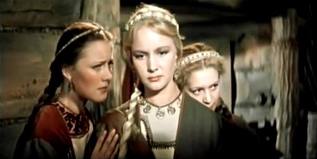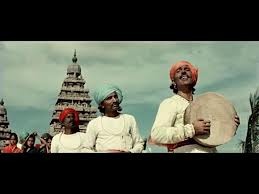Pardesi (1957)
This is a collection of articles archived for the excellence of their content.
|
Contents[hide] |
India’s first 'Scope (widescreen) film
By Parvez Dewan
Pardesi was a feature film with separate Hindi-Urdu and Russian versions. It was in Colour and wide-screen SovScope and was an Indo- Soviet co-production.
Pardesi was released in India in 1957, while Хождение за три моря ( Khozhdenie za tri morya ) was released in the USSR (Union of Soviet Socialist Republics) on 8 January 1958. Its subtitled English version, ‘Journey Beyond Three Seas,’ was premiered in New York in 1960.
The Hindi-Urdu version is said to be 152 min long, though on YouTube it is around 97 minutes long.
Even though it starred Nargis, the most successful heroine of the time, this biopic of Afanasi, a 15th century Russian explorer in India, did not get a theatrical release beyond left-leaning arthouse cinemas. T-Series has issued the film on DVD. The wide-screen SovScope format is intact but only a black and white print survives.
(Till the late 1960s many A grade, big budget [e.g. Saawan ki Ghata] as well as B+ films [e.g. Spy in Rome] were shot in 35mm and colour; however, several prints of these films were released in black and white and 16mm for rural markets and complimentary screenings at open-air defence services amphitheatres.)
The full Hindi-Urdu version is available on [YouTube] in B&W. Its Censor Certificate states ‘Colour, Scope’ and gives the name of its filmmakers as ‘Meera Movies’ and ‘Son[?]a Sansar International.’
The film's co-producer was Manmohan Sabir (the other producer's name was not mentioned in the credits of Pardesi). Abbas' name appears before Pronim's in the Hindi-Urdu version. Incidentally, V.M. Pronim is the spelling used in this version, though in the Soviet maestro's international biographies it is Pronin.
25 minutes of songs survive in colour
More excitingly, more than 25 minutes of the film are available in sharp, high quality colour and widescreen in the form of Hindi-Urdu songs [YouTube].
They must have been taken from the Russian version in which the songs appeared in Hindi-Urdu. The music is by Anil Biswas.
These colour and widescreen (SovScope) sequences and the Censor Certificate should establish beyond doubt which the first Indian film in widescreen was, and whether Pardesi can be considered an Indian film at all.
The spectacular Russian version
The Russian version, Хождение за три моря does not merely have a different soundtrack. It is not entirely a dubbed version of the Hindi Pardesi. It has a different treatment. The Russian version begins like a mega-budget Hollywood film with a mediæval ship tossing on the high seas, with Boris Tchaikovsky’s stirring orchestral music in the background. (Boris [1925-96] was inspired by the legendary Pyotr Ilyich but not related to him.)

We go through the beautiful Russian countryside before Afanasi (Oleg) enters a monastery. There he goes into a room and picks up a statuette that he obviously got from India.
The Hindi-Urdu versions begin roughly here, four and a half minutes after the Russian version. (There seem to be two Hindi versions with very minor differences in the credit titles.) There are no dialogues so far, so they could easily have used this sequence in the Hindi-Urdu version, dubbing Afanasi’s sole conversation with the monk. However, perhaps the conception of this section was considered too European for the Indian tastes of 1957.
The SovColor and SovScope version deserves to be seen just for its delectable photography, background music and mediæval Russian nostalgia.
Played on a good home theatre system the quality of sound of the Russian version is good enough for the 21st century, and the SovScope photography spectacular even by modern standards.
Hindi-Urdu versions did we say? Yes, because on YouTube there is a second Hindi-Urdu version as well, with differently shot credit titles, the second one spelling the Russian director’s name as Pronin.
The auteurs
Directors:
Khwaja Ahmad Abbas, Vasili Pronin
Writers:
Khwaja Ahmad Abbas, Mariya Smirnova
Producers:
Naya Sansar
Mosfilm
Cast
(In the order shown in the credits of Pardesi)
Nargis
Oleg [Strizhenov, who played Afanasi)
Balraj Sahni
Prithviraj Kapoor
Padmini
(In the alphabetical order)
Achala Sachdev
David Abraham
Iya Arepina
Manmohan Krishna
P. Jairaj
Stepan Kayukov
Varvara Obukhova
Vitali Belyakov
Technical auteurs
Music composers
Anil Biswas
Boris Tchaikovsky
Playback singers
Lata Mangeshkar
Manna Dey ...
Meena Kapoor ...
Cinematography:
Yevgeni Andrikanis, Vladimir Nikolayev, S. Ramachandra
Technical specifications
Color Sovcolor
Aspect Ratio
2.35 : 1
Some prints had the ratio: 1.37 : 1
Printed Film Format 35 mm
Awards
Khwaja Ahmad Abbas and Vasili Pronin were nominated for what was then and remains the world’s most prestigious award for a feature film, the Palme d'Or at the Cannes Film Festival 1958.
At the Filmfare Awards 1958, M.R. Achrekar won the Best Art Director award for the film.








